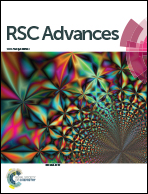Revisiting actinide–DTPA complexes in aqueous solution by CE-ICPMS and ab initio molecular dynamics†
Abstract
Although thermodynamics of AnIVDTPA− (DTPA = diethylenetriaminepentaacetic acid) complexation have been reported for 50 years, reliable data at low ionic strength is still missing. Owing to the use of capillary electrophoresis coupled with an inductively coupled plasma mass spectrometer, it is possible to simultaneously detect at ultra-trace level all AnIVDTPA− species in various conditions (concentration of ligand, pH) and to determine the formation constants. New values were obtained for tetravalent actinides with DTPA as well as with nitrilotriacetate (NTA) used as a competitor. Besides, the formation constants of hydrolyzed An(OH)DTPA2− species (An = Np, Pu) were also obtained for the first time using the variation of electrophoretic mobility as a function of pH at a constant DTPA concentration. The use of these data in radiotoxicology indicates that two stable species, namely PuDTPA− and Pu(OH)DTPA2− are present at approximately the same concentration in blood. From ab initio molecular dynamic (AIMD), the metal–oxygen distances dAn–O were calculated, and a linear relation was shown between dAn–O and the formation constants. The interpolation of data allowed determination of K values along the tetravalent actinide series, e.g. KNpDTPA−, KPaDTPA− and KU(OH)DTPA2−.


 Please wait while we load your content...
Please wait while we load your content...